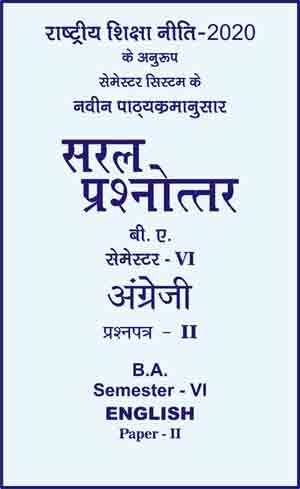|
बी ए - एम ए >> बीए सेमेस्टर 6 अंग्रेजी पेपर 2 बीए सेमेस्टर 6 अंग्रेजी पेपर 2सरल प्रश्नोत्तर समूह
|
|
||||||
बीए सेमेस्टर 6 अंग्रेजी पेपर 2
Chapter 5 - Social Media and its Types
Introduction to the Chapter
Social media has become an integral part of journalism, revolutionizing how news is sourced, reported, and consumed. Here’s an introduction to social media in the context of journalism, along with its various types:
Social Media in Journalism
- Role in Journalism
News Sourcing : Journalists use social media to discover breaking news, source information, and gather eyewitness accounts.
Audience Engagement : It allows journalists to engage directly with their audience, receiving instant feedback and gauging public opinion.
Content Distribution : Social media platforms are key channels for distributing news content, reaching wider and more diverse audiences.
- Advantages :
Speed : News can be reported in realtime.
Diversity of Perspectives : Access to a wide range of viewpoints and sources.
Interactivity : Enhanced interaction with audiences, fostering community discussions.
- Challenges :
Verification : The need for factchecking information sourced from social media.
Bias and Echo Chambers : Risk of encountering biased information and reinforcing beliefs within isolated communities.
Misinformation : Potential for rapid spread of false information.
Types of Social Media Used in Journalism
-
Social Networking Sites (e.g., Facebook, LinkedIn) :
Used for networking, sharing news stories, and engaging with readers.
Features like Groups and Pages facilitate focused discussions and communities. -
Microblogging Platforms (e.g., Twitter, Tumblr) :
Ideal for breaking news and realtime updates.
Hashtags help in tracking trending topics and public sentiment. -
Photo and Video Sharing Platforms (e.g., Instagram, YouTube, TikTok) :
Utilized for visual storytelling and reaching younger audiences.
Live streaming features enable onthespot reporting and viewer interaction. -
Content Aggregation and Discussion Sites (e.g., Reddit, Quora) :
Serve as sources for story ideas, public opinions, and expert insights.Communities and threads provide indepth discussions on various topics.
- Messaging Apps (e.g., WhatsApp, Telegram) :
Used for private communications, sourcing tips, and sharing news snippets.
Encrypted messaging offers secure channels for sensitive information.
In conclusion, social media has significantly transformed journalism, offering new tools for news gathering, storytelling, and audience engagement. Journalists must navigate this landscape skillfully, balancing the benefits of increased reach and interactivity with the responsibilities of accuracy and ethical reporting.
The Passitive and Negative Ettcet of Social Media
The impact of social media and the internet on people’s lives is profound and multifaceted, encompassing both positive and negative effects.
Positive Effects
-
Global Connectivity and Communication : Social media and the internet have removed geographical barriers, enabling people to connect with friends and family across the world instantly.
They facilitate cultural exchange and global understanding by allowing people to share and learn about diverse cultures and lifestyles. -
Access to Information : The internet is a vast repository of information on virtually every subject, making knowledge more accessible than ever.
Social media platforms provide realtime updates and diverse perspectives on current events. -
Educational Opportunities : Online learning platforms and educational resources have become widely accessible, allowing for selfpaced, flexible learning.
Social media groups and forums also serve as platforms for educational discussions and knowledge exchange. -
Economic Opportunities : The internet has created new job markets and career opportunities, particularly in tech, digital marketing, and remote working sectors.
Social media platforms are instrumental for marketing, networking, and brand building for businesses and entrepreneurs. -
Empowerment and Social Change : Social media has become a powerful tool for raising awareness about social issues and mobilizing for change.
It gives a voice to the marginalized and plays a significant role in grassroots movements.
Negative Effects
-
Misinformation and Fake News : The spread of false information on social media and the internet can have serious consequences, from personal harm to influencing public opinion and policy.
Discerning credible information from fake news can be challenging for users. -
Privacy Concerns and Data Security : Personal data is often collected and sometimes mishandled or exploited, leading to privacy breaches and security risks.
The internet is rife with cybercrimes like identity theft, phishing scams, and hacking. -
Mental Health Issues : Excessive use of social media has been linked to mental health issues like anxiety, depression, and loneliness.
The culture of comparison, cyberbullying, and online harassment contributes to these negative impacts. -
Addiction and Reduced Productivity : Internet and social media addiction is a growing concern, leading to reduced productivity and impacting personal relationships.
The compulsive need to check notifications and feeds can disrupt focus and worklife balance. -
Impact on Social Skills and Relationships : Overreliance on online communication can hinder the development of facetoface social skills, especially among younger generations.
Virtual interactions sometimes replace meaningful personal relationships, impacting the quality of social connections.
In summary, while social media and the internet offer unparalleled benefits in terms of connectivity, information access, and empowerment, they also pose significant challenges related to misinformation, privacy, mental health, and social dynamics. Balancing these aspects is crucial for harnessing the positive potential of these digital platforms while mitigating their negative impacts.
|
|||||

 i
i 









